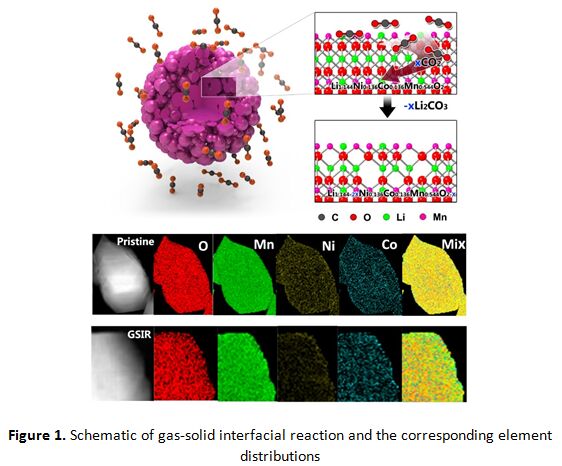With the commercialization of Li-ion batteries in the 1990’s, the layered oxide materials have dominated as the primary cathode materials since the earliest developed layered oxide, LiCoO2. Despite its achievements in performance and ubiquity in mobile devices, a drastic increase in energy density must be achieved to enable the widespread adoption of electric vehicles. Within the practical operating conditions of today, the current generation of layered oxide materials does not meet the future energy storage demands of over 300 Wh/kg at the cell level. One potential cathode material that can meet the high-energy demands is Li-rich layered oxide. Unlike the classical layered oxides, Li-rich layered oxide exhibits capacity around 300 mAh/g that goes beyond conventional topotactic mechanistic theoretical values. However, there are many issues and numerous scientific challenges, such as huge irreversible capacity loss, poor rate capability and voltage decay during cycling.
A research group led by Prof. Zhaoping Liu and Prof. Yonggao Xia, which is working on advanced Li-ion batteries, from Ningbo Institute of Materials Technology and Engineering, Chinese Academy of Sciences, have done many efforts on Li-rich layered oxide cathodes in the past years. Recently, this group reported a novel surface modification strategy manipulating gas-solid interface reaction between Li-rich layered oxides and carbon dioxide. The target material after surface modification is able to deliver discharge capacity as high as 301 mAh g-1 compared with that of 276 mAh/g for pristine electrode and increased initial coulombic efficiency from 83.8% to 93.2% at room temperature. Furthermore, the surface modified material could still exhibit discharge capacity as high as 300 mAh/g with no obvious capacity degradation after 100 cycles. This study also clarifies for the first time the critical influence of the activity of surface oxygen in enhancing the electrochemical performance. This work has been published in Nature Communications (2016, 7, 12108), and recognized as an important discovery on Li-rich layered oxide cathodes. This facile, scalable, and lost cost approach is under the large-scale development, which sheds light on design and optimization of next generation Li-ion batteries with high energy density.
This work was well done through international cooperation with Prof. Ying Shirley Meng in University of California San Diego (UCSD), Prof. Yimei Zhu in Brookhaven National Laboratory (BNL) and Dr. Jun Wang in University of Muenster, and was supported by Strategic Priority Research Program of Chinese Academy of Sciences (Grant No. XDA09010101), Key Projects in Cooperation between CAS and Department of Energy, USA (CAS-DOE, Grant No. 174433KYSB20150047), and Ningbo Science and Technology Innovation Team (Grant. No. 2012B82001).


Prof. Zhaoping Liu: liuzp@nimte.ac.cn
Prof. Yonggao Xia: xiayg@nimte.ac.cn
Research Gruop Url:http://english.nimte.cas.cn/rh/rd/newenergy/battery/batresearch/
All Images by ![]()

